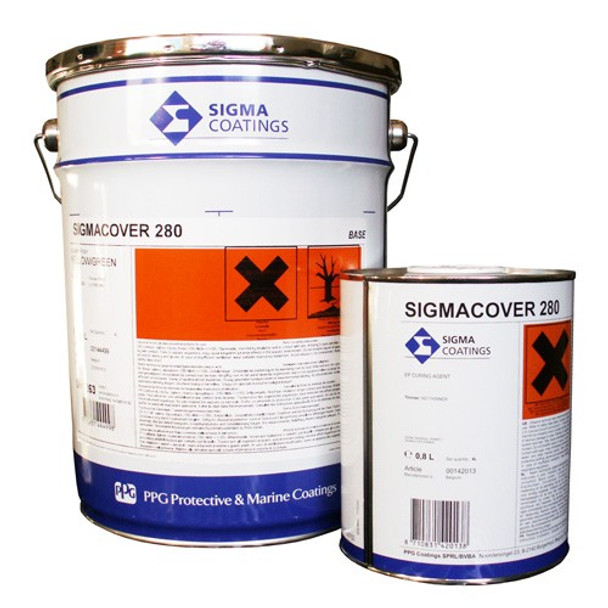Sigma marine paints
Sigmacover 280 Sigma Marine paint
- SKU:
- Sigma-Cover-280
- Weight:
- 18.00 KGS
- Shipping:
- Calculated at Checkout
Description
Sigmacover 280 Sigma Marine paint
GZ Industrial Supplies Limited is a distributor of Sigma marine coatings in Nigeria Our Sigmacover 280 sigma marine paint is a universal epoxy primer system used for such places as ballast tanks, decks, topsides, superstructure, hull and cargo oil tanks.
Characteristics of Sigmacover 280 Sigma Marine paint
- Universal epoxy primer system suitable for Ballast Tanks, Decks, Topside, Superstructure, Hull and Cargo Oil Tanks
- General-purpose epoxy primer in protective coating systems for steel and non-ferrous metals
- Good adhesion to steel and galvanized steel
- Good adhesion to non-ferrous metals
- Good flow and wetting properties
- Good water and corrosion resistance
- Cures at temperatures down to 5°C (41°F)
- Suitable for touching up of weld seams and damages of epoxy coatings during construction
- Excellent recoatability
- Can be overcoated with most alkyd-, chlorinated rubber-, vinyl-, epoxy- and two-component polyurethane coatings
- Suitable on wet blast cleaned substrates (damp or dry)
- Compatible with well-designed cathodic protection systems
RECOMMENDED SUBSTRATE CONDITIONS AND TEMPERATURES
Immersion exposure
- Steel or steel with not approved zinc silicate shop primer; blast cleaned (dry or wet) to ISO-Sa21⁄2, blasting profile 30 - 75 μm (1.2 – 3.0 mils)
- Steel with approved zinc silicate shop primer; weld seams and areas of damaged shop primer or breakdown should be blast cleaned to ISO-Sa21⁄2, blasting profile 30 - 75 μm (1.2 – 3.0 mils) or power tool cleaned to SPSS-Pt3
- Coated steel; hydrojetted to VIS WJ2L (blasting profile 30 – 75 μm (1.2 – 3.0 mils))
- IMO-MSC.215(82) requirements for water ballast tanks
- Steel; ISO 8501-3: 2006 grade P2, with all edges treated to a rounded radius of minimum 2 mm (0.0789 in) or subject to three pass grinding
- Steel or steel with not approved zinc silicate shop primer; blast cleaned to ISO -Sa21⁄2, blasting profile 30 – 75 μm (1.2 – 3.0 mils)
- Steel with approved zinc silicate shop primer; weld seams and areas of shop primer damage or break down should be blast cleaned to Iso-Sa 21⁄2 blasting profile 30 – 75 μm (1.2 – 3.0 mils): [1] For shop primer with IMO type approval; no additional requirements; [2] For shop primer without IMO type approval; blast cleaned to ISO-Sa2 removing at least 70% of intact shop primer, blasting profile 30 – 75 μm (1.2 – 3.0 mils)
- Dust quantity rating "1 for dust size class "3", "4" or "5", lower dust size classes to be removed if visible on the surface to be coated without magnification (ISO 8502-3:1992)
- Atmospheric exposure conditions
- Steel blast cleaned to ISO-Sa21⁄2, blasting profile 30 - 75 μm (1.2 – 3.0 mils) or according to ISO-St3
- Shop primed steel; pretreated to SPSS-Pt3
- Galvanized steel must be sweep blasted or otherwise roughened
- Galvanized steel must be free from grease, salts and any contamination
- Concrete / Masonry
- Remove grease, oil and other penetrating contaminants according to ASTM D4258
- Abrade the surface per ASTM D4259 to remove all chalk and surface glaze or laitance. Achieve surface profile - ICRI CSP
- 3 to 5
- AMERCOAT 114 A may be used as a pit filler for certain applications. Check with PPG Technical Service for guidance on
- chemical resistance
- Maximum recommended moisture transmission rate is 3 lbs / 1,000 ft2 / 24 hours by moisture transmission test (ASTM
- F1869, calcium chloride test or by ASTM D4263, plastic sheet test)
- Alternatively, ASTM D4944 (Calcium Carbide Gas method) can be used, moisture content should not exceed 4%
Substrate temperature and application conditions
- Substrate temperature during application and curing should be above 5°C (41°F)
- Substrate temperature during application and curing should be at least 3°C (5°F) above dew point
- Relative humidity during application and curing should not exceed 85%
INSTRUCTIONS FOR USE
- The temperature of the mixed base and hardener should preferably be above 15°C (59°F), otherwise extra thinner may be required to obtain application viscosity
- Adding too much thinner results in reduced sag resistance and slower cure
- Thinner should be added after mixing the components
Frequently Asked Questions
1. How long does marine paint take to dry?
Drying times can vary depending on the type of paint, environmental conditions, and the thickness of the applied coat. Typically, marine paint may take a few hours to dry to touch, but it may take several days for a full cure. Refer to the paint manufacturer's guidelines for specific drying times.
2. Can I apply antifouling paint over old antifouling paint?
In most cases, yes, antifouling paint can be applied over old antifouling paint. However, proper surface preparation is essential to ensure good adhesion. It's recommended to consult the paint manufacturer's instructions for specific guidance.
3.Can I paint my boat in any weather conditions?
Weather conditions can significantly affect the paint application and drying process. It's generally recommended to paint in dry, well-ventilated conditions with moderate temperatures. Avoid painting in direct sunlight, high humidity, or during windy or rainy conditions.
Related Articles
Contact us for quotations and availability in your location
17 Reviews
-
THE VERY BEST coating
good SIGMA MARINE PAINTS SIGMACOVER 280 SIGMA MARINE PAINT
-
Very nice
SIGMA MARINE PAINTS SIGMACOVER 280 SIGMA MARINE PAINT
-
Reliable
SIGMA MARINE PAINTS SIGMACOVER 280 SIGMA MARINE PAINT
-
Excellent product
This product is very durable
-
premium quality
nice and excellent
-
Original Sigma coatings sold here
Sigma coatings I purchased here was directly from the PPG
-
Best place to buy industrial goods
Nice product
-
Best quality at the best price
I was happy I can get the best paint products at GZ, such a great team






